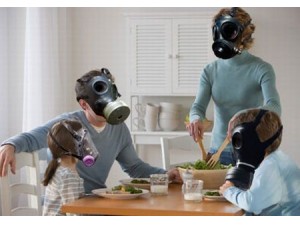For your health, you should learn about Sick Building Syndrome.

How does a person or researcher decide if a building is a sick or not? If people have headaches and allergic-like reactions to unspecified stimuli that seems linked to the time they spend in a building while at the same time have a lack of symptoms when they are not in those buildings, that is a clue.
In the 1970s, health care providers were faced with increasing numbers of people having headaches, dizziness, lethargy, fatigue, nausea, irritation of mucous membranes, eye and or nasopharyngeal irritation, and sensitivity to odors. In other words, acute health effects that seemed to be linked to time spent in a building, but no specific illness or cause can be identified.
When tied to a particular building this spectrum of specific and non specific complaints have become known as sick building syndrome. This is not the same as an illness that refers to a specific airborne illness such as Legionnaires Disease.
Over time, the construction of buildings has increasingly focused on energy savings and comfort. Central heating and cooling systems are considered as necessary in all of our modern buildings. Home and office construction has moved toward minimizing heat or cool air loss by making buildings more airtight. Heating and cooling systems recycle a large portion of the air that we breathe.
The problem is made worse at the same time by more complex materials that are being used for clothing, furniture, fabrics, cleaners, detergents and preservatives. Together these and other similar trends have generated buildings where the exposure to foreign particles, dust and gases have exceeded the normal standards.
What Causes Sick Building Syndrome?
In some EPA studies, indoor studies of some volatile organic compounds ( VOCs ) can be up to 10 times greater than outdoors. A very large array of potential sources of VOCs exist in our homes and offices including:
- Scents and hair sprays
- personal products
- household products such as finishes
- rug and oven cleaners
- pesticides
- Paints and thinners
- dry cleaning fluids
- some copiers/printers
- adhesives
- markers
- photo solutions
Environmental combustion products, from stoves, fireplaces, unvented space heaters along with tobacco smoke can cause indoor pollutants at harmful levels.
Biological air pollutants are found everywhere, dander, mold, dust mites, pollen, bacteria and viruses. These contaminants can breed in stagnant water that has accumulated in humidifiers, drain pans and ducts where water has collected Three types of human disease can come from biological contaminants.
Infections in which pathogens invade human tissue; hypersensitivity diseases which involve specific activity of the immune system; and toxicosis in which biologically produced chemical toxins cause direct toxic effects. Biological contaminants can be the cause of fever, chills, muscle aches, chest tightness and allergic reactions.
People who work in offices from the cleaning staff up to the top Executives are not immune to sick building syndrome. According to the U.S. Department of Energy ( DUE ), improving buildings and indoor environments could reduce healthcare costs and sick leave and increase worker performance, resulting in an estimated productivity gain of $30 billion to as much as $150 billion annually.
The Department of Energy further estimated that the potential decrease in adverse health effects from improvement in indoor environments to be 10 percent to 30 percent for infectious lung disease, allergies and asthma and 20 percent to 50 percent for sick building syndromes.
For the United States the corresponding annual healthcare savings plus productivity gains are; $6 billion to 19 billion from reduced lung disease, $1 billion to $4 billion from reduced allergies and asthma, $10 billion to $20 billion from reduced Sick Building Syndrome symptoms and $12 billion to $125 billion dollars from direct improvements in worker performance unrelated to health.
What are possible solutions to Sick Building Syndrome?
Solutions to Sick Building syndrome usually include but not limited to the following steps:
- Increasing ventilation and air distribution is often a very cost effective means of reducing indoor pollutants. At minimum heating, ventilation, and air conditioning ( HVAC ) systems should be designed to meet ventilation standards in local building codes.
- Filters and ducts should be changed or cleaned on a regular basis. this will help with pollutant build up over time due to poor air exchange.
- Air cleaners such as air scrubbers and air purifier units will also help clean up the pollutants in the environment.
- Removal or modification of pollutant sources is the most effective approach to solving a known source of an indoor air quality problem.
- Using and storing paints, solvents, pesticides and adhesives in closed containers in well ventilated areas.
- Using those type of materials in periods of low or no occupancy and by venting the fumes to the outdoors.
- Adding live plants through out the area will also increase better air quality to the environment.
- With the ban of smoking in many buildings this is also helping reduce the symptoms of Sick Building Syndrome.
Education and communication are important parts of any air quality management program. When all who are involved with the building from occupants to maintenance, fully understand the issues and communicates with. each other they can work more effectively to prevent and solve problems.
To go to the top of this page on sick building syndrome, click here.
Home | Articles | Family Tips | Money/Business | Health/Fitness |
House Tips | Auto Tips | Sports/Hobbies | Grandma's Tips |
Wisdom & Humor |





